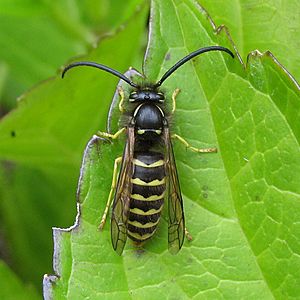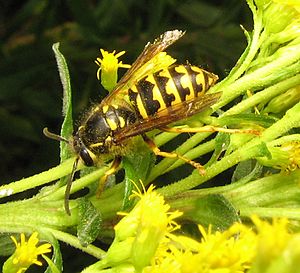Common aerial yellowjacket facts for kids
Quick facts for kids Dolichovespula arenaria |
|
|---|---|
 |
|
| Scientific classification |
Dolichovespula arenaria, also known as the common aerial yellowjacket, is a type of wasp. You might also hear it called the sandhills hornet or common yellow hornet. These wasps live all across North America.
Contents
What Kind of Wasp Is It?
D. arenaria belongs to a group, or genus, called Dolichovespula. This genus is part of the Vespidae family. In North America, wasps in this group are often called yellowjackets. There are 18 species in the Dolichovespula genus. Some other well-known species include D. saxonica and the D. maculata.
How to Spot a D. arenaria Wasp
D. arenaria wasps are mostly yellow. You can tell them apart from other yellow wasps in their group by looking at their body markings. They have special yellow markings on the first two parts of their abdomen. Unlike some other wasps, they usually don't have black marks near their eyes.
The queen wasp has large black spots on the fourth and fifth parts of her abdomen. She also has smaller spots on the second and third parts.
Male wasps, called drones, have longer antennae. They also have spots on the fourth and fifth parts of their abdomen. Their abdomen ends in a flat, "fuzzy" shape instead of a pointed stinger.
Their nests are made of dull gray paper-like material. They usually have one to six layers of comb inside. Sometimes, the nest color can change based on what materials the wasps find.
Where Do They Live?
The common aerial yellowjacket lives all over Canada and the United States. You can find them from northern Alaska down to New Mexico and Arizona. They are very common in eastern North America.
These wasps build their nests in many places. They can be found in trees, shrubs, or even underground. In cities, they often build their nests on buildings.
How a Colony Grows
A queen wasp starts a new colony in the spring. She picks a spot and builds a small paper nest. Then, she lays her eggs inside. When the eggs hatch, they become larvae (baby wasps). The queen feeds these larvae.
These first larvae grow up to become worker wasps. Once there are workers, the colony starts to grow much faster. The workers look different from the queen. The queen is the only one who lays eggs to make more workers.
In the Dolichovespula group, worker wasps often produce male wasps (drones). These colonies usually last for about one year. They grow strong in the summer and then slowly die out as winter arrives.
Wasp Interactions with Other Animals
Who Eats These Wasps?
D. arenaria nests are often high up in trees. This means they don't have many predators. Birds sometimes eat them. Other wasps might also attack them.
Some mammals will try to get to a nest if it's in an easy-to-reach spot. They want to eat the larvae, which are full of nutrients. Animals like skunks, opossums, raccoons, and even bears might try to raid a nest.
What Do They Eat?
D. arenaria workers mostly hunt and eat live insects and spiders. They catch many different kinds of prey. This includes grasshoppers, crickets, caterpillars, flies, and even lady beetles. They also eat young hummingbirds.
Sometimes, these wasps will feed on dead animals. They have been seen eating parts of dead dogs, pigs, and snakes. They often hunt for food high up in trees, usually between 2 to 4 meters off the ground.
How Do They Defend Themselves?
Smaller wasp colonies are usually less aggressive than larger ones. People have different ideas about how aggressive D. arenaria wasps are. Some say they are easily angered, while others say they are not. This difference might depend on whether someone is near their nest or just seeing a single worker wasp away from the nest. Smaller colonies might act in surprising and unpredictable ways when defending their home.
Venom Spraying
A unique defense for D. arenaria wasps is that they can spray venom from their stingers. This has been seen in workers from large colonies. When they spray venom, it helps release a special chemical signal. This signal tells other yellowjackets to attack, helping them defend the nest.
Parasites That Affect Them
D. arenaria nests can be affected by two main parasites. One is a type of wasp called Sphecophaga vesparum burra. The other is another social parasite wasp called D. arctica.
Female bee moths (Aphomia sociella) also lay their eggs in D. arenaria nests. The moth larvae hatch and then eat the wasp eggs, larvae, and pupae. They can cause a lot of damage to the nest as they tunnel through it looking for food.
Sphecophaga vesparum burra
It's not very common for S. v. burra to parasitize D. arenaria nests. When they are present, they don't seem to stop the wasp colony from growing. This is different from how this parasite affects other Dolichovespula species.
D. arctica
Not much is known about D. arctica. These wasps are parasites and don't have their own worker wasps. They rely on new nests to raise their young. The parasite wasp kills the queen of the host nest before she can make her own workers. Then, the parasite takes over the nest. However, the parasite's life is short after the host queen dies.


